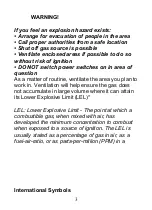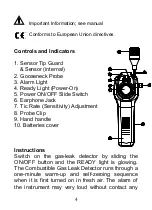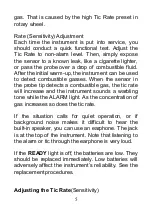
6
The tic rate tells you when the sensor (in the tip of
the instrument) is getting close to a leaking gas. You
can control the tic rate using the rotary wheel in the
center of the instrument.
Move the wheel clockwise to increase the
frequency
Move the wheel counter-clockwise to decrease
the frequency
A tic rate of 4 to 8 tics per second, in fresh air, is
typical. As the sensor comes near a combustible
gas source, the tic rate increases. In order to isolate
the source of a leak, you may need to move the
wheel counter clockwise, decreasing the sensitivity,
as the sensor moves closer.
Replacing the Batteries
Replace your 1.5 volt /size R14C(B) alkaline
batteries when:
• The green
READY
light off
• No light or other activity occurs upon turning the
instrument on
To replace the batteries:
1. Lay the instrument face-down on a back face.
2. Remove the battery cover. Apply upward
pressure to the tab at the bottom of the battery
cover while lifting it out.
3. Remove the batteries using a coin or screwdriver,
if necessary, to pry them out.
4. Replace all three batteries with new ones.
Содержание GD-3300
Страница 1: ...User s Manual Combustible Gas Leak Detector Model GD 3300...
Страница 11: ...10...











